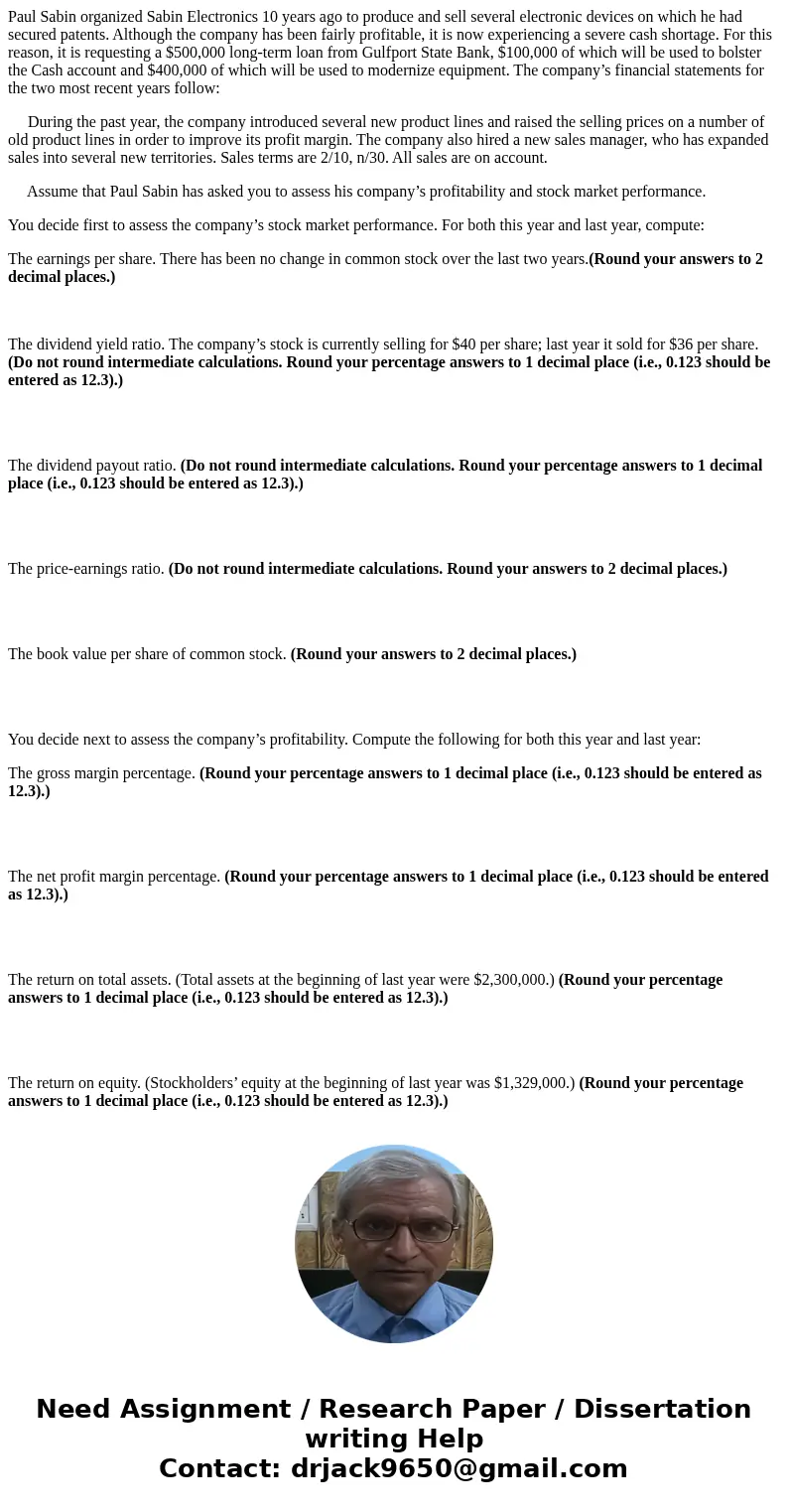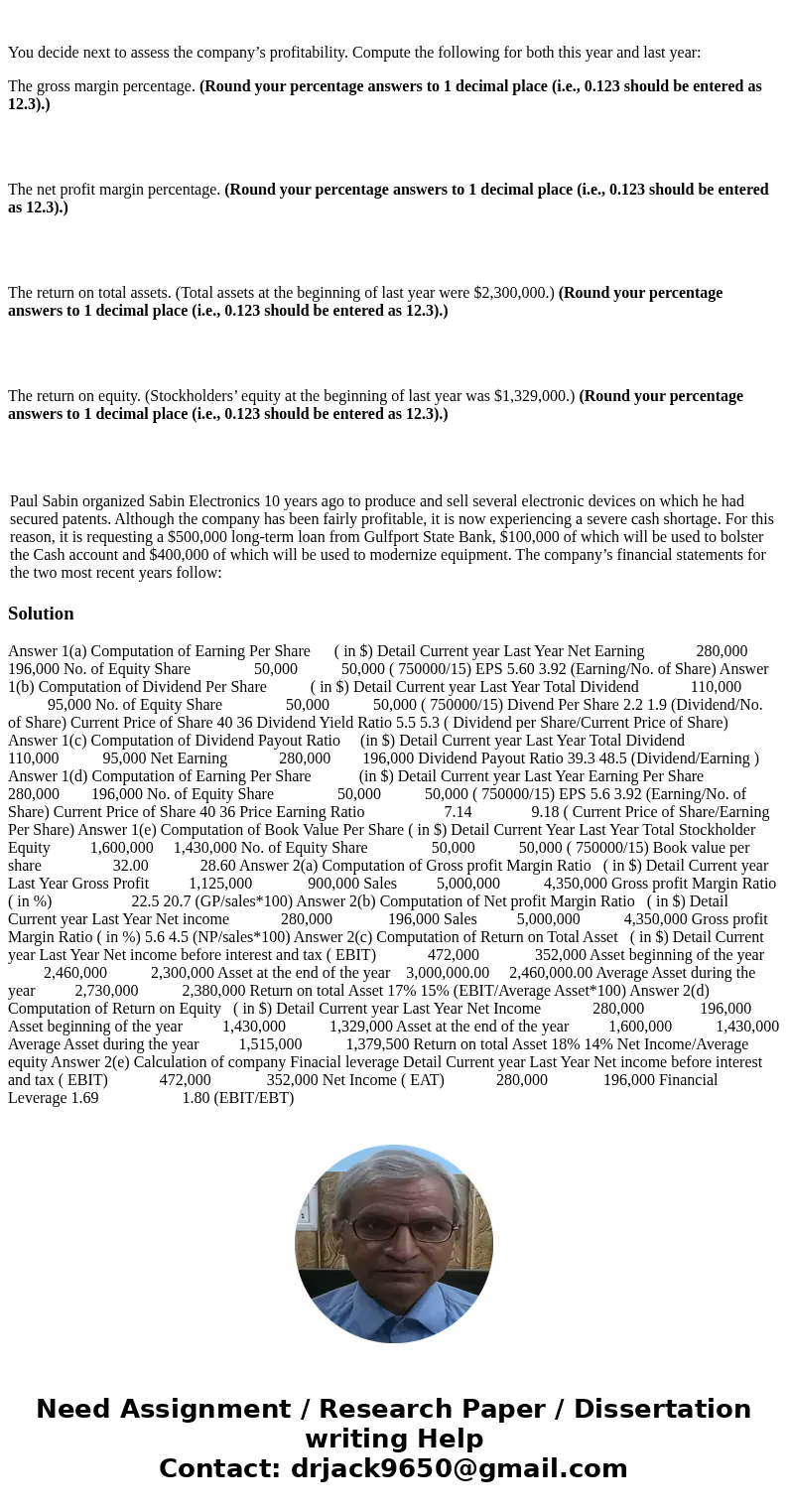Paul Sabin organized Sabin Electronics 10 years ago to produ
Paul Sabin organized Sabin Electronics 10 years ago to produce and sell several electronic devices on which he had secured patents. Although the company has been fairly profitable, it is now experiencing a severe cash shortage. For this reason, it is requesting a $500,000 long-term loan from Gulfport State Bank, $100,000 of which will be used to bolster the Cash account and $400,000 of which will be used to modernize equipment. The company’s financial statements for the two most recent years follow:
During the past year, the company introduced several new product lines and raised the selling prices on a number of old product lines in order to improve its profit margin. The company also hired a new sales manager, who has expanded sales into several new territories. Sales terms are 2/10, n/30. All sales are on account.
Assume that Paul Sabin has asked you to assess his company’s profitability and stock market performance.
You decide first to assess the company’s stock market performance. For both this year and last year, compute:
The earnings per share. There has been no change in common stock over the last two years.(Round your answers to 2 decimal places.)
The dividend yield ratio. The company’s stock is currently selling for $40 per share; last year it sold for $36 per share. (Do not round intermediate calculations. Round your percentage answers to 1 decimal place (i.e., 0.123 should be entered as 12.3).)
The dividend payout ratio. (Do not round intermediate calculations. Round your percentage answers to 1 decimal place (i.e., 0.123 should be entered as 12.3).)
The price-earnings ratio. (Do not round intermediate calculations. Round your answers to 2 decimal places.)
The book value per share of common stock. (Round your answers to 2 decimal places.)
You decide next to assess the company’s profitability. Compute the following for both this year and last year:
The gross margin percentage. (Round your percentage answers to 1 decimal place (i.e., 0.123 should be entered as 12.3).)
The net profit margin percentage. (Round your percentage answers to 1 decimal place (i.e., 0.123 should be entered as 12.3).)
The return on total assets. (Total assets at the beginning of last year were $2,300,000.) (Round your percentage answers to 1 decimal place (i.e., 0.123 should be entered as 12.3).)
The return on equity. (Stockholders’ equity at the beginning of last year was $1,329,000.) (Round your percentage answers to 1 decimal place (i.e., 0.123 should be entered as 12.3).)
| Paul Sabin organized Sabin Electronics 10 years ago to produce and sell several electronic devices on which he had secured patents. Although the company has been fairly profitable, it is now experiencing a severe cash shortage. For this reason, it is requesting a $500,000 long-term loan from Gulfport State Bank, $100,000 of which will be used to bolster the Cash account and $400,000 of which will be used to modernize equipment. The company’s financial statements for the two most recent years follow: |
Solution
Answer 1(a) Computation of Earning Per Share ( in $) Detail Current year Last Year Net Earning 280,000 196,000 No. of Equity Share 50,000 50,000 ( 750000/15) EPS 5.60 3.92 (Earning/No. of Share) Answer 1(b) Computation of Dividend Per Share ( in $) Detail Current year Last Year Total Dividend 110,000 95,000 No. of Equity Share 50,000 50,000 ( 750000/15) Divend Per Share 2.2 1.9 (Dividend/No. of Share) Current Price of Share 40 36 Dividend Yield Ratio 5.5 5.3 ( Dividend per Share/Current Price of Share) Answer 1(c) Computation of Dividend Payout Ratio (in $) Detail Current year Last Year Total Dividend 110,000 95,000 Net Earning 280,000 196,000 Dividend Payout Ratio 39.3 48.5 (Dividend/Earning ) Answer 1(d) Computation of Earning Per Share (in $) Detail Current year Last Year Earning Per Share 280,000 196,000 No. of Equity Share 50,000 50,000 ( 750000/15) EPS 5.6 3.92 (Earning/No. of Share) Current Price of Share 40 36 Price Earning Ratio 7.14 9.18 ( Current Price of Share/Earning Per Share) Answer 1(e) Computation of Book Value Per Share ( in $) Detail Current Year Last Year Total Stockholder Equity 1,600,000 1,430,000 No. of Equity Share 50,000 50,000 ( 750000/15) Book value per share 32.00 28.60 Answer 2(a) Computation of Gross profit Margin Ratio ( in $) Detail Current year Last Year Gross Profit 1,125,000 900,000 Sales 5,000,000 4,350,000 Gross profit Margin Ratio ( in %) 22.5 20.7 (GP/sales*100) Answer 2(b) Computation of Net profit Margin Ratio ( in $) Detail Current year Last Year Net income 280,000 196,000 Sales 5,000,000 4,350,000 Gross profit Margin Ratio ( in %) 5.6 4.5 (NP/sales*100) Answer 2(c) Computation of Return on Total Asset ( in $) Detail Current year Last Year Net income before interest and tax ( EBIT) 472,000 352,000 Asset beginning of the year 2,460,000 2,300,000 Asset at the end of the year 3,000,000.00 2,460,000.00 Average Asset during the year 2,730,000 2,380,000 Return on total Asset 17% 15% (EBIT/Average Asset*100) Answer 2(d) Computation of Return on Equity ( in $) Detail Current year Last Year Net Income 280,000 196,000 Asset beginning of the year 1,430,000 1,329,000 Asset at the end of the year 1,600,000 1,430,000 Average Asset during the year 1,515,000 1,379,500 Return on total Asset 18% 14% Net Income/Average equity Answer 2(e) Calculation of company Finacial leverage Detail Current year Last Year Net income before interest and tax ( EBIT) 472,000 352,000 Net Income ( EAT) 280,000 196,000 Financial Leverage 1.69 1.80 (EBIT/EBT)

 Homework Sourse
Homework Sourse